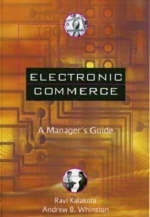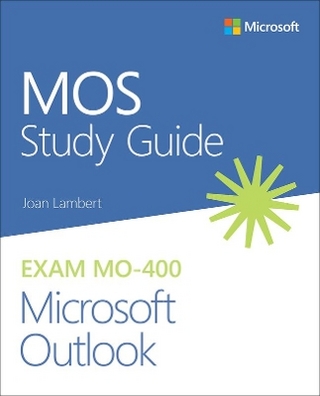
Electronic Commerce
Addison Wesley (Verlag)
978-0-201-88067-0 (ISBN)
- Titel ist leider vergriffen;
keine Neuauflage - Artikel merken
How do you manage electronic commerce? What is the technology behind electronic commerce? Electronic Commerce: A Manager's Guide is the ideal starting point for business managers and professionals involved with electronic commerce, as well as professionals/users who want to keep abreast of the latest trends and issues in management practices affected by electronic commerce technology. Authors Ravi Kalakota and Andrew Whinston take a down-to-earth approach to a very important business subject, with insightful examples to show how ideas have been put into practice. Highlights *Provides a clear overview of what electronic commerce is all about. *Specifies the business uses and technology directions of the World Wide Web *Clarifies management issues facing Internet Service Providers. *Explains firewalls, transaction security, and electronic payment methods. *Describes electronic commerce applications and challenges in banking, retailing, and publishing. *Covers electronic commerce applications internally within the corporation -- supply-chain management, manufacturing, and finance. 0201880679B04062001
Dr. Ravi Kalakota is a pioneer in the area of e-commerce. He is the CEO of e-Business Strategies, a technology research and consulting practice, and has consulted extensively with start-ups and Fortune 1000 companies. Andrew B. Whinston is the Cullen Chair Professor of Information Systems, Computer Science and Economics, IC2 Fellow, and Director of the Center for Information Systems Management at the University of Texas at Austin. His recent research interests are Internet pricing and application of client/server computing to support groups working collaboratively. 0201880679AB04022003
1. Introduction to Electronic Commerce.
Defining Electronic Commerce.
Brief History of Electronic Commerce.
Forces Fueling Electronic Commerce.
Electronic Forces.
Marketing and Customer Interaction Forces.
Technology and Digital Convergence.
Implications of Various Forces.
Electronic Commerce Industry Framework.
The Information Superhighway.
Multimedia Content and Network Publishing.
Messaging and Information Distribution.
Common Business Services Infrastructure.
Other Key Support Layers.
Putting the Framework into Action: Microsoft Corporation.
Types of Electronic Commerce.
Inter-organizational Electronic Commerce.
Intra-organizational Electronic Commerce.
Consumer-to-Business Electronic Commerce.
Intermediaries and Electronic Commerce.
Key Questions for Management.
Competitive Pressure.
External Threat.
Incorporating Changes.
Designing New Organizational Structures.
Managerial Options and Priorities.
Summary.
2. The Internet and the Access Provider Industry.
Internet Service Providers.
Key Market Drivers for the Internet.
Who Is Making Money on the Internet.
Clarifying Internet Terminology.
Companies Providing Internet Access.
Internet Topology.
Differentiating Market Segments: Commercial versus Consumer.
Internet versus Online Services.
Open versus Closed Architecture.
Controlled Content versus Uncontrolled Content.
Metered Pricing versus Flat Pricing.
Innovation versus Control.
Predicting the Future of the IAP Market.
Convergence Leading to Competition.
Service and Capacity Management.
Customer Service, Loyalty, and Retention.
Marketing.
Customer Education.
Changing Technology behind Internet Access.
Changing Technology behind the Access Provider.
Summary.
3. World Wide Web--Applications.
Brief History of the Web.
What Exactly Is the Web?
Why Is the Web Such a Hit?
The Web and Ease of Use.
The Web and Ease of Publishing.
The Web as a New Distribution Channel.
The Web and Network-Centric Computing.
The Web and New Intra-Business Applications.
The Web and Electronic Commerce.
The Web and Intra-Business Commerce.
Other Intranet Applications.
Intranet Advantages and Disadvantages.
Management of Intranets.
Understanding the Intranet Architecture.
Summary.
4. World Wide Web--Concepts and Technology.
Key Concepts behind the Web.
Overview of the Web's Technical Architecture.
Interactive Web Applications.
Interactive Applications.
Interactivity and Information Integration.
Web Extensions for Interactive Applications.
Web and Database Integration.
Web Database Products.
HTML Forms and CGI Programs.
Web Software Developmental Tools.
Need for Better Programming Languages.
New Programming Language: Java.
Technically Speaking: What Exactly Is Java?
Role of Java in Electronic Commerce.
How Does Java Work?
Business Reasons for Using Java.
Multimedia Web Extensions.
Virtual Reality Modeling Language (VRML).
RealAudio.
Internet and Web-based Telephony.
Directories and Search Engines.
Lycos.
Summary.
5. Firewalls and Transaction Security.
Firewalls and Network Security.
Types of Firewalls.
Firewall Security Policies.
Emerging Firewall Management Issues.
Transaction Security.
Types of Online Transactions.
Requirements for Transaction Security.
Encryption and Transaction Security.
Secret-Key Encryption.
Public-Key Encryption.
Implementation and Management Issues.
World Wide Web and Security.
Netscape's Secure Sockets Layer.
Security and Online Web-based Banking.
Summary.
6. Electronic Payment Systems.
Overview of the Electronic Payment Technology.
The Online Shopping Experience.
Limitations of Traditional Payment Instruments.
Electronic or Digital Cash.
Properties of Electronic Cash.
Digital Cash in Action.
Electronic Checks.
Benefits of Electronic Checks.
Electronic Checks in Action.
NetCheck: A Prototype Electronic Check System.
Electronic Check Project.
Online Credit Card-Based Systems.
Types of Credit Card Payments.
Secure Electronic Transactions (SET).
Other Emerging Financial Instruments.
Debit Cards at the Point of Sale (POS).
Debit Cards and Electronic Benefits Transfer.
Smart Cards.
Consumer, Legal, and Business Issues.
Summary.
7. Electronic Commerce and Banking.
Changing Dynamics in the Banking Industry.
Changing Consumer Needs.
Cost Reduction.
Demographic Trends.
Regulatory Reform.
Technology-based Financial Services Products.
Home Banking History.
Why Will It Be Different This Time?
Home Banking Implementation Approaches.
Home Banking Using Bank's Proprietary Software.
Banking via the PC Using Dial-Up Software.
Banking via Online Services.
Banking via the Web: Security First Network Bank.
Open versus Closed Models.
Management Issues in Online Banking.
Differentiating Products and Services.
Managing Financial Supply Chains.
Pricing Issues in Online Banking.
Marketing Issues: Attracting Customers.
Marketing Issues: Keeping Customers.
Back-Office Support for Online Banking.
Integrating Telephone Call Centers with the Web.
Summary.
8. Electronic Commerce and Retailing.
Changing Retail Industry Dynamics.
Overbuilding and Excess Capacity.
Demographic Changes.
Consumer Behavior.
Technology Improvements in Electronic Retailing.
Online Retailing Success Stories.
Online Retailing: Peapod's Experience.
CUC International.
Wine on the Web: Virtual Vineyards.
Web-based Travel Agencies.
Mercantile Models from the Consumer's Perspective.
Distinct Phases of a Consumer Mercantile Model.
Prepurchase Preparation.
Purchase Consummation.
Postpurchase Interaction.
Management Challenges in Online Retailing.
Come Up with a Retailing Strategy.
Manage Channel Conflict.
Learn to Price Online Products/Services.
Deliver a Satisfying Shopping Experience.
Design the Layout of an Online Store.
Manage Brands.
Create the Right Incentives.
Summary.
9. Electronic Commerce and Online Publishing.
Why Online Publishing?
Online Publishing Strategies.
Online Publishing Approaches.
Full-Text and Bibliographic Databases.
Personalized and Customized News.
Business Information and News Delivery.
Edutainment = Education + Entertainment.
Online Publishing Success Stories.
PointCasting.
Time Warner's Pathfinder.
Disney Online.
Integrating TV and Data Streams: Intercasting.
Advertising and Online Publishing.
An Online Publishing Missing Piece: Measurement.
Digital Copyrights and Electronic Publishing.
Online Copyright Protection Methods.
Summary.
10. Intranets and Supply-Chain Management.
Supply-Chain Management Fundamentals.
Pull versus Push Supply-Chain Models.
Elements of Supply-Chain Management.
Integrating Functions in a Supply Chain.
Managing Retail Supply Chains.
The Order Management Cycle (OMC).
Supply-Chain Application Software.
Software for Supply-Chain Management.
Recent Trends in Application Software.
What Is the Business Market?
Understanding the Application Software Architecture.
Future of Supply-Chain Software.
Intranets and Network-Centric Computing.
Intranets and Application Software.
Impact of the Web on Application Software.
Elaborating on the Intranet Architecture.
What Remains to Be Done?
Summary.
11. Intranets and Customer Asset Management.
Why Customer Asset Management?
Challenges in Implementing Customer Asset Management.
Customer Asset Management and Supply Chains.
Online Sales Force Automation.
What Is Sales Force Automation?
Elements of Online Sales Automation.
Intranets and Sales Automation.
What Are the Management Issues?
Online Customer Service and Support.
The Web and Customer Service.
The Role of Technology in Customer Service.
What Are the Business Requirements?
The Enabling Intranet Technology.
Technology and Marketing Strategy.
Marketing Decision Support Systems.
Marketing Decision Support Applications.
Summary.
12. Intranets and Manufacturing.
Defining the Terminology.
Integrated Logistics.
Agile Manufacturing.
Emerging Business Requirements.
Customer-Driven Manufacturing.
Rapid Internal Response to Demand Changes.
Efficiently Managing Supply Chain Complexity.
Manufacturing Information Systems.
Discrete versus Process Manufacturing Market.
Types of Manufacturing Information Systems.
Intranet-Based Manufacturing.
Customer-Driven Manufacturing.
Real-Time Decision Support.
Intelligent Process Management.
Logistics Management.
Problems with Traditional Logistics Management.
Case Study: Microsoft Corp Integrated Logistics.
Objective of Modern Logistics Function.
Forecasting.
Purchasing.
Distribution Management.
Electronic Data Interchange (EDI).
Benefits of EDI.
EDI in Action.
Why Has EDI Adoption Lagged?
Summary.
13. Intranets and Corporate Finance.
Intranets and Finance.
What Exactly Are Financial Systems?
What Do Financial Systems Do?
Financial Intranets.
Understanding the Different Software Modules.
Transaction Accounting and Electronic Commerce.
Financial Analysis and Management Accounting.
Inventory Accounting.
Payment Management.
Treasury and Cash Management.
Human Resources Management Systems.
HRMS Functions.
Size/Structure of Financials Software Market.
Product Strategy.
Financial Data Warehouses.
How Are Firms Using the Web for OLAP?
Desirable Software Requirements.
Summary. 0201880679T04062001
| Erscheint lt. Verlag | 31.1.1997 |
|---|---|
| Verlagsort | Boston |
| Sprache | englisch |
| Maße | 235 x 160 mm |
| Gewicht | 587 g |
| Themenwelt | Informatik ► Netzwerke ► Mail Server |
| Mathematik / Informatik ► Informatik ► Theorie / Studium | |
| Wirtschaft ► Betriebswirtschaft / Management | |
| ISBN-10 | 0-201-88067-9 / 0201880679 |
| ISBN-13 | 978-0-201-88067-0 / 9780201880670 |
| Zustand | Neuware |
| Informationen gemäß Produktsicherheitsverordnung (GPSR) | |
| Haben Sie eine Frage zum Produkt? |
aus dem Bereich

